Words By: Kit Belen
In the recent years, technology has grown and gave way to a new breed of rods and reels that are lightweight and tough enough to stand up against the harshness of the saltwater environments. Anglers were quick to recognise the potential of these new rods and reels for finesse applications that were previously only used by freshwater anglers. With the number of bigger fish dwindling or the fishing pressure increasing, we have to evolve with the conditions and look for ways around it and be successful in our outings.
It has been an accepted fact that the lighter you fish, the more strikes you get. The problem with this is also the fact that when you go lighter, you also need to ensure that everything you do – from tying knots to selecting and presenting it to the fish, is going to get more challenging.
Your knot tying should be better than just good. Fishing with light line means you have to scale everything down – if you tie knots with nothing less than perfection, it would mean lessening your chances because you are staring with lines that test less than 5kg, tying a knot with lines as light as these would further weaken it, resulting in knots breaking, lost fish, bruised egos and endless cursing.

The Tackle
Rods
There are a lot of brands to suit each angler’s preference and pocket depth. For anglers, such as myself, that are very budget conscious; there are rods from Abu Garcia and Berkley that fit the bill well. My choice is almost always a rod with a rating of 8-17lb. (4-10kg) with a minimum length of seven feet (213cm); if I can get a longer one, I would. The perfect length for me would be around 9-10 feet (274-304cm). Although you will find rods of this length, they are almost always Japanese Domestic Market models (JDM) and are mostly expensive. If you can afford these rods, I highly recommend them because they will take off a lot of limitations (such as casting distance, better backbone power, sensitivity, etc). Of the few rods I use, my favourite is a 9-foot (274cm) Majorcraft Solpara Seabass series rod, costing about 500 AED in Barracuda Dubai. Of course there are times when a shorter rod is best and that is when I’m fishing in a place where I don’t really need to cast that far to get to fish or when I’m on a kayak or boat, in which case a more traditional (short) ultralight rod is used.
Reels
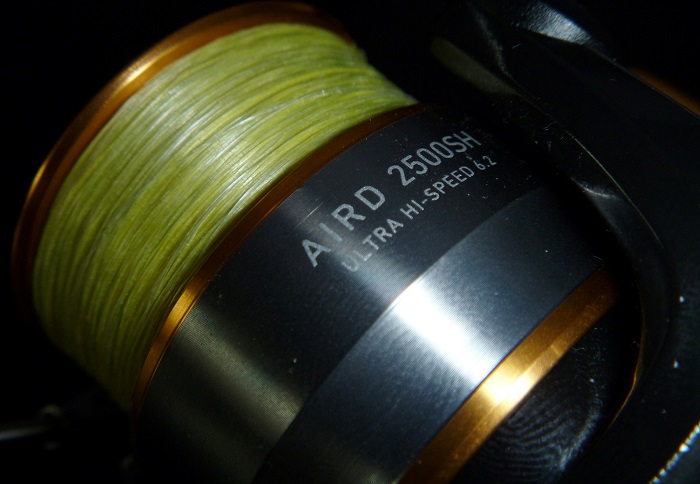
Spinning reels were initially invented because there was a need to cast small and light lures – I believe, we are in the Golden Age of Spinning Reels right now.
People skip all the headaches and use spinning reels for this purpose, most are priced reasonably and are very easy to use – for this type of fishing; you are looking at reels within the 1000 to 3500 size range (Shimano and Penn sizing) with 2500 and 3000 being the norm.
Depending on which size of line you want to use, these reels typically hold about 300 meters of braided line (or PE line if you want to go with the Japanese sizing system). You don’t have to go overboard – you want a reel that would be able to take the punishment of table sized fish – realistically, nothing over 5kg. Spending on an expensive reel is a matter of choice. I use a Daiwa Aird 2500SH, it has 9 ball bearings, a light composite body and a large capacity extra spool – All those features for under 300AED (and if you don’t mind, the funky colour scheme!)
Line braid Is the line choice of the modern era in most situations. It gives you a thinner diameter line that enables you to cast small, light lures farther than you would with monofilament. Braid is also three times stronger than it’s equivalent mono diameter. Which means a braid that has a breaking strain of 10lb (5kg) would be the same diameter as 3lb (1.5kg) mono. At a braid testing it was found out that, a 10lb (5kg) braid would beak at about 15-16lbs (7.5-8kg). Braid has very little stretch, which helps keep you in contact with your lure even if you are dealing with long casts. Paired with a very sensitive rod, you could almost feel the fish breathe on your lure before it strikes! Braid makes your diving lures dive deeper because it has less resistance, cuts down on drag when you are fishing areas with high current so you get your lures or bait down and keep them in the strike zone. Because of these qualities, braid would also enable you to use lighter lures to reach the bottom. Seems like the perfect line? It’s not. It works in most situations and you have to be a bit experienced to really make use of it. If you are still starting out, I suggest you use mono because the main drawback of braid is the cost. The best ones will set you back about 300 AED per spool, the mid-range ones will cost about 200 AED on average – stay away from the cheap ones. They will give you more frustration with wind knots (tangles) and you spend time mending your line than fishing. I use a 4lb (2kg) to 6lb (3kg) braid (+/- PE 0.3-PE 0.4). If my braid is not enough to fill the spool, I use a length of mono for backing, or old used braid.
Leaders
Nylon is in most cases good enough. Although a lot of people use fluorocarbon leaders nowadays, I don’t really use a lot of it unless I am fishing for tuna. As fishing is mostly based on personal preference, if you feel that your chances are higher if you use fluorocarbon, go ahead and use it, it will most likely make you fish with more confidence and will have your lure in the water more as a result and if the lure is in the water, you are always in for chance at a fish.
Lures
In my opinion, you spend most of your money on lures in the long run, than you do with your rod and reel. I label lures as “consumables”. You can’t have just one, you can’t use them forever, you lose them even if you take good care of them, one way or another, they get banged up and will eventually need to be replaced — and you need more than one colour for a specific one, two or more if the lure is “that good”.
There are a ton of lures in the market available to confuse the angler, you could easily get lost with the choices even in the smallest of tackle shops. To make the choice easier lets break them down to the 3 types I use most often:
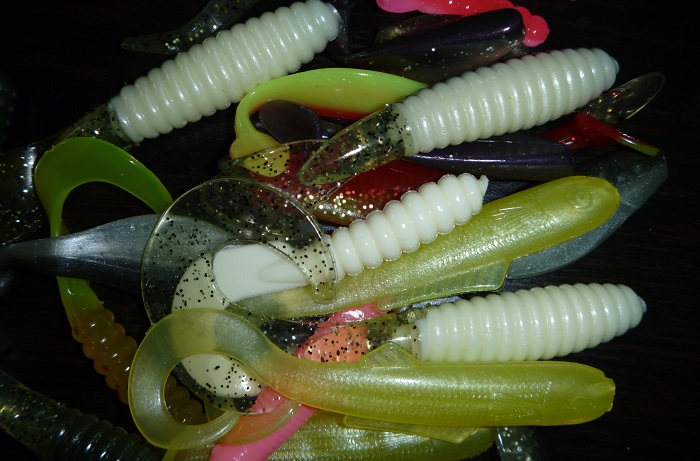
- Soft plastics – These are made of gummy plastic and shaped like small fish, shrimp, crab, worms and other small critters – basically these are the closest thing to real bait. They are the easiest to use but also the one that gets chewed up the fastest. You mount them on a jig head: a hook with a weighted head or a weighted shank. Using them is as easy as casting them out and reeling them in on or close to the bottom. Their tails move on their own and just as long as it’s moving fish will bite. There are some brands with scents in them (like the Berkley Gulp! baits) that have fish attracting enzymes, even if you don’t move these things, they can catch fish – It is that easy! Jig heads of 3-5 grams with plastic bodies will catch fish in almost any fishing condition/situation.
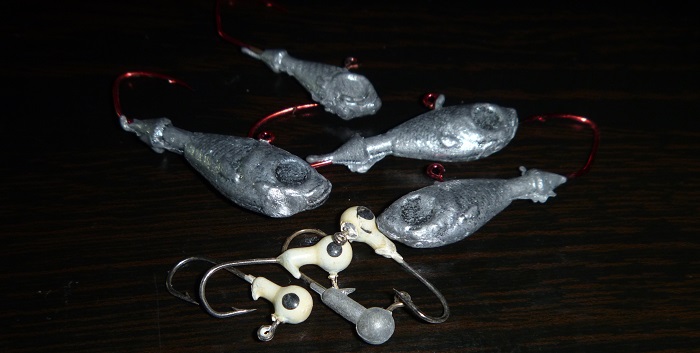
- Small swimming Jigs – these are chunks of metal shaped like fish. They wobble when you reel them in slowly, reel them too fast and they spin. These lures are perfect when you want to cast a long way like when fishing off the beach, jetties and piers. They cast like bullets and are easy to use, just cast them out and reel them in a slow and steady retrieve, when you feel the lure pulsing you know you are doing it right. Nothing over 10g for these, but you can check your rod on exactly what your lure weight is. My rod takes up to 12gI believe.
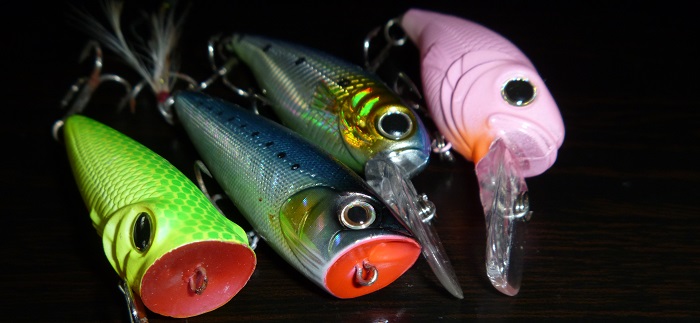
- Plugs – These are the fish shaped lures made of plastic or wood with “lips” and armed with treble hooks. Again, very easy to use; cast out and reel in. These lures are great, but I don’t really like using them that much because of the treble hooks and they take up a lot of space. If I do use them, I like the small stick baits and poppers – when fishing for fish like Gold Spot Trevally or Golden Trevally, the explosion they create when chasing after these top water lures are more than enough to get you addicted to them.
You might have noticed that I didn’t mention anything about lure colours, this is because I believe that any coloured lure will catch fish because of movement rather than anything else. Fish feel what’s around them by feeling vibrations in the water with their lateral line, and only switch to visuals when they are very close by. In muddy water, they don’t even see your lures! In my opinion, colour selection is a personal preference and that the more you like the colour, the more you fish with it. If by chance you are standing in front of a row of lures and are confused of what to buy, or what to stock up on, get the ones that look natural, or ones that attract you the most. I like using whites, pinks in clear water and dark colours like black and brown in stained or muddy water.
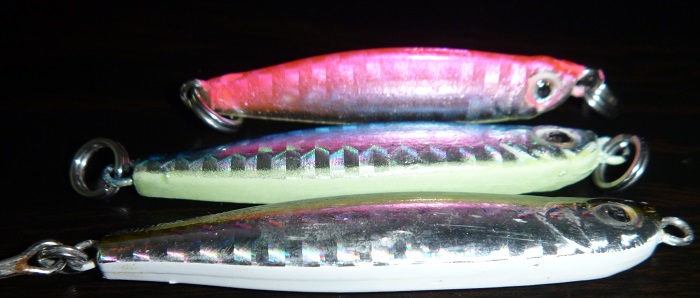
This type of fishing is not for everyone; the expense alone on mid end gear will set you back by about 1000 AED. But the fun and challenge it gives you is something you don’t outgrow till you get old and grey. It is very applicable in the UAE and when do you go with this type of fishing, you end up packing a little less because everything is scaled down. Add a small bag to hold a small box of lures and leaders and you set yourself up as a very mobile and flexible fishing unit. Smaller lures and lighter gear doesn’t really mean smaller fish – Elephants eat peanuts as they say. Think about it this way – instead of feeding the fish a meal, you are feeding them snacks, and we all know you eat more snacks than you do with full meals.
Till the next tide change,
Kit

